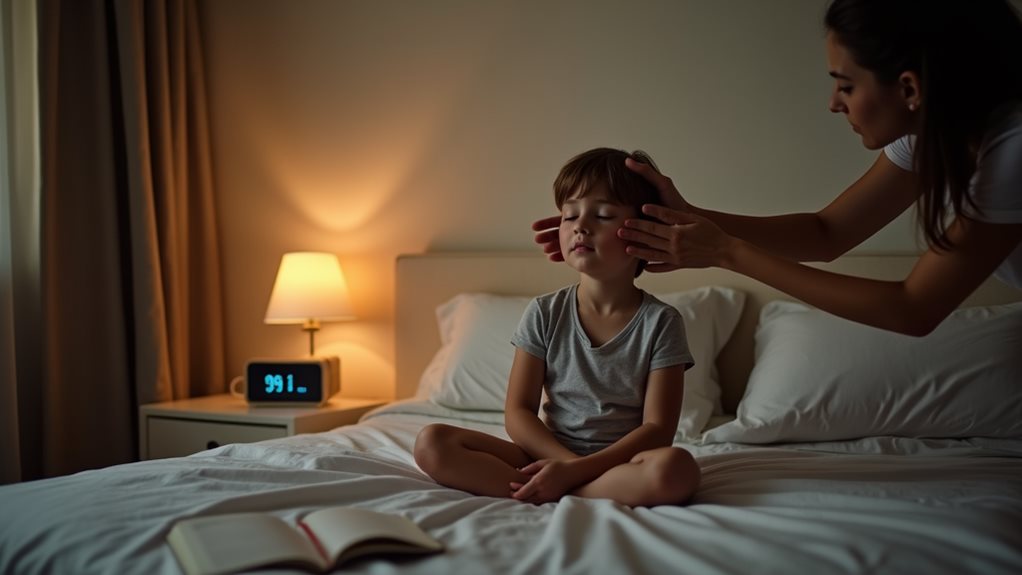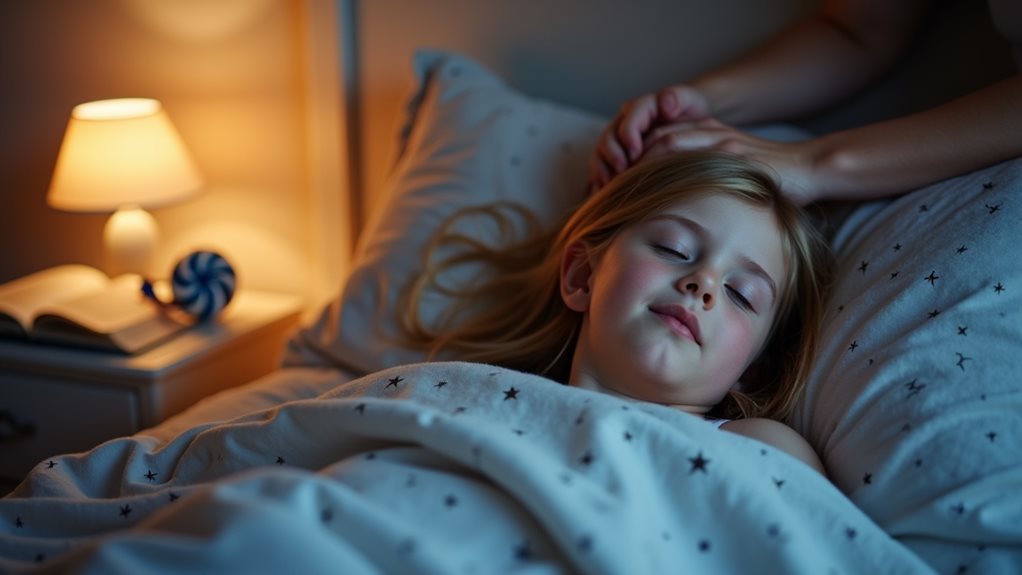
Hypnosis and Emotional Freedom Techniques (EFT) effectively address bedtime fears by accessing the subconscious to instill calm and diminish anxiety. Hypnosis guides the mind toward relaxation through soothing suggestions, while EFT employs tapping on specific body points to release emotional stress. Combined, these methods provide an all-encompassing approach to overcoming nighttime worries, enhancing sleep quality. Further exploration of these techniques reveals deeper insights into their mechanisms and benefits for sustained fear relief and restorative sleep.
Key Takeaways
- Hypnosis uses deep relaxation and positive suggestions to address subconscious triggers of bedtime fear.
- EFT combines tapping on specific body points with verbal affirmations to release fear-related stress.
- Creating a calming bedtime routine enhances the effectiveness of Hypnosis and EFT in reducing anxiety.
- Both techniques lower stress hormone levels, promoting a more relaxed and restful state conducive to sleep.
- Regular practice of Hypnosis and EFT can transform negative nighttime experiences into peaceful, fear-free rest.
Understanding the Roots of Bedtime Fear
Understanding the roots of bedtime fear is essential for developing effective intervention strategies. Often, these fears are anchored in childhood experiences that have imprinted a lasting impact on an individual's psyche.
Environmental triggers such as inconsistent bedtime routines or a sleep environment that feels unsafe can reactivate these deep-seated anxieties.
Scientifically, the brain's response to these triggers can be observed through heightened alertness and anxiety, disrupting normal sleep patterns.
The Role of Hypnosis in Alleviating Nighttime Anxiety
While many individuals grapple with nighttime anxiety, hypnosis emerges as a promising therapeutic tool, offering a pathway to calm and restorative sleep. This approach utilizes hypnotic suggestions tailored to promote deep relaxation and address the subconscious triggers of anxiety.
By integrating relaxation techniques, such as guided imagery and controlled breathing, hypnosis helps individuals shift into a state of mental and physical ease. These techniques facilitate a change in perception, allowing the mind to focus on positive, calming thoughts rather than dwell on the anxieties that disrupt sleep.
Consequently, hypnosis can greatly enhance the quality of nighttime rest.
Emotional Freedom Techniques: Tapping Into Fear Relief

Building on the serene foundation laid by hypnosis for managing nighttime anxiety, Emotional Freedom Techniques (EFT), commonly known as tapping therapy, offer another effective tool in the arsenal against sleep-related fears.
By utilizing specific tapping techniques on the body's meridian points, EFT facilitates an emotional release, helping individuals process and alleviate their fears. This method combines focused verbal expression of specific fears with physical tapping, creating a dual-action approach to fear management.
The scientific basis behind EFT lies in its ability to reduce the stress hormone levels, thereby promoting relaxation and diminishing the physiological manifestations of anxiety.
Neuro-Linguistic Programming: Reframing Thoughts for Better Sleep
Neuro-Linguistic Programming (NLP) offers a transformative approach to managing bedtime fears by reframing negative thought patterns that disrupt sleep.
Utilizing NLP techniques, individuals learn to identify and alter detrimental inner dialogues, replacing them with positive affirmations. This process not only mitigates anxiety but also cultivates a mindset conducive to restful sleep.
By systematically changing how thoughts are internally represented, people can influence their emotional responses to nighttime. The scientific basis of NLP supports its effectiveness in transforming fear into calmness, thereby enhancing overall sleep quality.
This method empowers individuals to reclaim control over their sleep, leading to healthier nighttime habits.
Creating and Sustaining a Comforting Bedtime Routine

Following the successful application of Neuro-Linguistic Programming strategies for managing bedtime anxiety, it is beneficial to establish a consistent and comforting bedtime routine to further enhance sleep quality.
Cultivating specific bedtime rituals, such as reading or gentle yoga, can notably soothe the mind and prepare the body for rest.
Optimizing the sleep environment by maintaining a cool temperature, using soft lighting, and minimizing noise contributes to a sense of tranquility.
These practices not only reinforce a psychological association between these rituals and sleep but also promote a stable circadian rhythm, essential for deep, restorative sleep and overall well-being.
Combining Hypnosis and EFT for Comprehensive Treatment
Merging hypnosis and Emotional Freedom Techniques (EFT) offers a thorough approach to tackling bedtime fears and sleep phobias.
Hypnosis utilizes relaxation and visualization techniques, guiding individuals through Mindful Meditation to reach a tranquil state. Concurrently, EFT focuses on specific meridian points to alleviate emotional distress.
This combination allows for a thorough treatment by addressing both the conscious and subconscious layers of fear. By integrating these methods, patients can reconstruct their mental framework around sleep, promoting a more serene bedtime experience.
This dual approach not only soothes immediate anxiety but also fortifies long-term resilience against sleep-related fears.
Tracking Progress and Adjusting Approaches for Optimal Results

As treatment progresses, the importance of monitoring outcomes and making necessary adjustments becomes apparent in managing bedtime fears effectively.
Progress evaluation is essential in guaranteeing the adopted strategies such as hypnosis and EFT are yielding the desired results. Approach modification might be necessary when progress stalls or if specific anxieties evolve.
- Regular Feedback Sessions: To assess comfort levels and anxiety triggers.
- Adaptation of Techniques: Modifying methods based on individual responses.
- Continuous Monitoring: Keeping track of improvements or setbacks in sleep patterns.
This systematic tracking and tailored adjustment guarantee the therapeutic interventions remain effective and responsive to the evolving needs of the individual.
Frequently Asked Questions
Can Hypnosis Cause Dependency for Sleep Improvement?
Hypnosis typically does not lead to addiction or sleep reliance. It is a therapeutic tool used to modify subconscious patterns and improve sleep, without fostering dependency when applied by a qualified professional.
Are There Age Restrictions for Using EFT for Bedtime Fears?
EFT techniques for bedtime fears generally lack strict age restrictions. However, adaptations in approach are necessary for different age groups to guarantee safety and effectiveness, reflective of developmental considerations and individual emotional maturity.
How Does One Measure Progress in Overcoming Sleep Phobia?
To measure progress in overcoming sleep phobia, one typically uses sleep assessments to track improvements in fear reduction, frequency of peaceful nights, and changes in anxiety levels before and during bedtime.
Is It Safe to Combine Medication With Hypnosis and EFT?
Combining medication with alternative therapies requires careful consideration of safety and potential medication interactions. Consulting healthcare professionals guarantees a harmonious approach, enhancing therapeutic benefits while mitigating risks in a scientifically informed and empathetic manner.
What Alternative Therapies Complement Hypnosis and EFT for Sleep Issues?
Alternative therapies complementing hypnosis and EFT for sleep issues include aromatherapy, benefiting relaxation through essential oils, and meditation techniques that enhance mindfulness and stress reduction, scientifically proven to improve overall sleep quality.
Conclusion
In addressing bedtime fears, the integration of hypnosis and Emotional Freedom Techniques (EFT) offers a promising avenue. A study indicates that 40% of adults experiencing sleep disruptions report improvement after such interventions. This holistic approach not only mitigates immediate anxiety but also reshapes cognitive associations with sleep, fostering lasting tranquility. As research expands, these therapies underscore a significant step towards enhancing sleep quality, essential for overall well-being.





